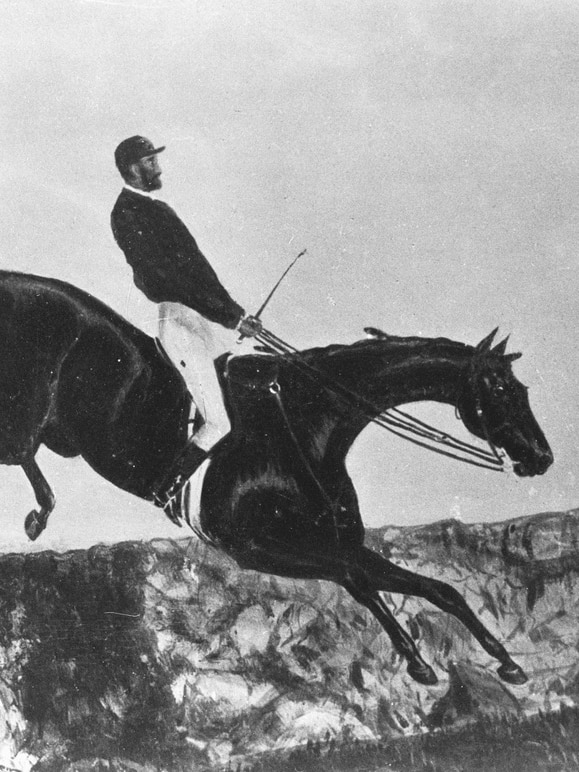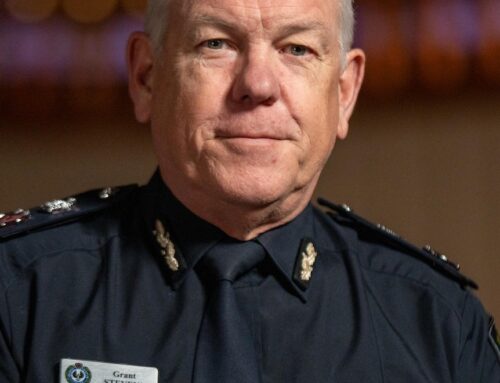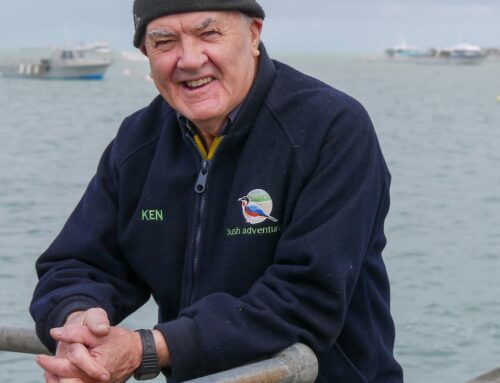Adam Lindsay Gordon is known for many things — as a poet, colonial politician and horseman — but in SA’s South East, he may be best known for a daring jump near one of the region’s landmarks.
Riding along the road around Mount Gambier’s famous Blue Lake with other riders, it is said Mr Gordon jumped a fence onto a narrow ledge overlooking a steep drop into the lake below.
After sticking the landing, Mr Gordon jumped back over the fence and continued riding.
The feat is memorialised with an obelisk at the site.
“They used to dare each other to do certain things, and he decided he’d do something that he thought the others couldn’t do,” said Lorraine Day, who has written two books on Mr Gordon.
“They thought he was mad, and he probably was to attempt something like that.”
The leap is part of Mr Gordon’s legacy, which 154 years on from his death, Ms Day and other passionate fans of his are trying to keep alive.
Who was Adam Lindsay Gordon?
Ms Day, who is now on the the Adam Lindsay Gordon Commemorative Committee, didn’t start off an expert.
She said she had never learnt about him in school.
“It was only then [putting the book together] I realised that some of his famous words … were something my grandfather used to recite,” she said.
Born in 1833, Mr Gordon arrived in Adelaide from England in 1853 and joined the police force as a mounted trooper.
He was first stationed temporarily at Mount Gambier before being sent to Penola.
He became well-known as a horseman after resigning from the force.
“As he became better known, he was approached to stand for parliament,” Ms Day said.
He spent just over 18 months from March 1865 to November 1866 as a member for the electorate of Victoria.
Mr Gordon began to make a name as a poet, with his work appearing in newspapers.
Just before his parliamentary career, Mr Gordon bought Dingley Dell cottage near the beachside town of Port Macdonnell.
Mr Gordon moved to Victoria in 1867, but with debts mounting — including the cost of publishing his poetry books — and suspected mental health concerns linked to hard falls from his horses, he died by suicide at Brighton Beach on June 24, 1870.
The day prior, his second collection, Bush Ballads and Galloping Rhymes, had been published.
In death, Mr Gordon’s popularity grew, and he became internationally renowned.
A memorial dedicated to him was erected in Mount Gambier in 1887, overlooking the Blue Lake where he performed his famous leap.
A statue of Mr Gordon, pen in one hand and notebook in the other, was erected in Melbourne in 1931.
In 1934, he became the only Australian to have his bust placed in Poets’ Corner in Westminster Abbey.
“He really embraced the Australian landscape and people,” Ms Day said.
“He had an individual voice and interpretation of the Australian bush.”
Cottage museum closed for years
The Dingley Dell cottage eventually became a popular tourist attraction too, acting as a museum dedicated to Mr Gordon’s time in the region.
For 23 years, caretakers Allan and Jenny Childs oversaw the cottage and ran public tours.
But it has rarely been open since the couple left the role in 2020.
“It definitely is a landmark and you always hear people talking about it and referring to it,” Grant District Mayor Kylie Boston said.
“I think the more of these things that we can keep open for people to come and have a look is a good idea.”
Ms Boston said it was important to preserve the site and tell Mr Gordon’s story.
“That history is always really important, so we need to be keeping those so we’ve got them there for our next generation to come visit and understand,” she said.
While some artefacts remained within the cottage, more significant items were being held in secure storage in Mount Gambier until a new lessee took over.
Ms Day said she wanted to see the cottage reopened so people could learn about Mr Gordon’s impact.
“Lots of people have said they went down that way and the place was all closed,” she said.
“We’re trying to safeguard the fact that any new lease arrangement will allow regular public access.”
Preserving for the future
The SA Department for Environment and Water has opened public consultation on a draft management plan for the cottage until September.
It comes after the Hundred of Comaum Trust received a grant of $233,000 in 2021 to install 20 ecologically sensitive 20 semi-permanent tents for accommodation.
“National Parks and Wildlife Service continues to maintain the site until any future lease holder takes over care of the cottage,” a department spokesperson said.
They said the plan tried to balance potential new tourism offerings with heritage and conservation.
“Subject to the outcome of the consultation for the new management plan, the department will continue to work exclusively with The Hundred of Comaum Trust for a new lease to operate the proposed tourism accommodation and heritage and nature tourism experiences,” they said.
However, the spokesperson said no potential lessee would have exclusive use of the entire park.
Get our local newsletter, delivered free each Friday




